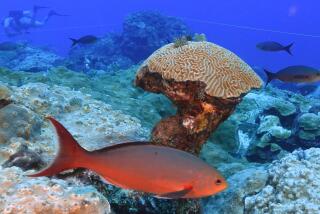Deep-Sea Discoveries From Abandoned Mission
- Share via
WASHINGTON — After fleeing Hurricane Katrina, ocean researchers have returned to the Gulf of Mexico where they are getting a revealing look at the deep sea.
“We are exploring the deep sea with new eyes,” oceanographer Tamara Frank of the Harbor Branch Oceanographic Institution said Friday.
Frank and others aboard the National Oceanic and Atmospheric Administration research vessel Seward Johnson are using a camera that operates with dim red light to study life on the sea floor.
They have found a variety of deep-dwelling shellfish that produce their own light, animals with surprising ability to see ultraviolet light and a previously unknown type of squid, six feet long, that attacked their camera.
“Imagine, something that big that had never been seen before,” scientist Edith A. Widder, who recently left Harbor Branch, said in a telephone briefing.
When Katrina moved into the Gulf of Mexico the researchers retreated, first to Louisiana and then to Galveston, Texas.
They left the 200-pound camera on the bottom. When they returned it had been upended, but they don’t think that was done by the storm. The camera was 1,800 feet deep, where storm effects would be minimal.
They think a large predator probably upset the camera. Unfortunately the battery had run down so they didn’t get a picture of it. They have filmed sharks attacking the camera before.
Past studies of deep ocean life had used bright white light or looked at animals brought up in nets, Frank said.
Unfortunately, the animals caught in nets are often badly damaged and the white light blinds these creatures.
With the red-light camera they have gotten pictures of animals and even been able to capture some and bring them to the surface without blinding them. They are kept in the dark with only dim red light which they don’t seem to be able to see.
The chambers are filled with cold seawater. The change in pressure doesn’t seem to affect animals such as crabs and shrimp, which don’t have air-filled swim bladders, the researchers said.
Some have the ability to see ultraviolet light, Frank said. They are trying to determine why. “As far as we know there is no ultraviolet light down there,” she said. One theory is that it helps them see creatures that produce their own biological fluorescence.
“The discovery that one of the deep-sea crabs has ultraviolet vision is thrilling,” said Widder. “The question is what the heck are they doing with it.”
More to Read
Sign up for Essential California
The most important California stories and recommendations in your inbox every morning.
You may occasionally receive promotional content from the Los Angeles Times.













